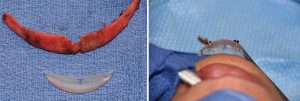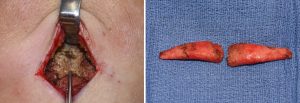Background: While chin augmentation is commonly performed and numerous implants styles and sizes exist to perform it, the patient’s gender should have an influence in the process. While men tend to prefer stronger and more square chin augmentation results, most women prefer a more subtler result with less augmentation and a rounder or even tapered frontal look. The key to a successful aesthetic outcome is to match the implant chosen to the patient’s desired look.
The most popular style of chin implant used today is the anatomic which has extended wings that go back along the jawline on each side. This makes theoretical sense since it helps blends the central part of the implant back along the jawline. But one aesthetic tradeoff for doing so is that it makes the chin wider. It can not help in doing so because it adds material around the corners of the chin. While it may only be a few millimeters per side it is nonetheless visible given the bony surface area covered.
While chin augmentation is a 3D dimensional procedure, most surgeons focus primarily on the horizontal dimension. To illustrate that point almost every chin augmentations result seen on the internet is in the profile view. But patient’s infrequently view themselves in profile and most know their face more in the frontal and three-quarter views. A successful horizontal chin augmentation may have less desired effects in either the vertical or transverse dimensions.
Case Study: This middle aged female had a prior chin augmentation procedure with her rhinoplasty. She had a Medpor chin implant placed through a submental incision. While she was pleased with the subsequent profile view of her chin, she was unhappy with the wider her chin had become.



The most common reason in my experience that women want their chin implants either revised or removed is that it is either too big or makes the chin too wide. My women prefer a more narrow or tapered chin frontally and often expected that an implant will help to do so.
Case Highlights:
1) Chin augmentation in women needs to be vigilant of how its appearance will change in the frontal view.
2) Some men need more central chin implant styles to avoid creating a wide chin.
3) For chin implant revisions in women an extended chin implant style can be replaced with a central style which will require screw fixation.
Dr. Barry Eppley
Indianapolis, Indiana




